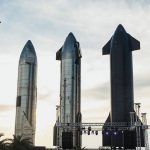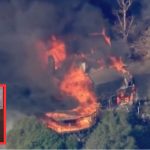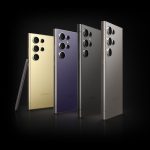“So those restrictions that apply for broader Sydney apply to the CBD obviously on New Year’s Eve as well. So unless you have a permit to go to someone’s home with not more than 10 people, or you have a permit from Service NSW to attend a hospitality venue, nobody should be in the CBD at all.”The lockdown on the Northern Beaches is also being extended.The northern section – which has seen more coronavirus activity – will have its lockdown extended until January 9. On New Year’s Eve, households will be able to welcome five visitors, and all must come from within the northern zone.The southern section will have its lockdown extended until the January 2, with Ms Berejiklian saying she hopes to incorporate this zone into the greater Sydney zone on January 2.Those households will be able to welcome 10 visitors, and all must come from within the southern zone.Those holding private gatherings for New Year’s Eve are encouraged to keep their gatherings outdoors. Businesses must also have a QR Code system in place by January 1, 2021.
More details on NSW rules can be found by scrolling below.
NEW COVID REPORT SHOWS NEW FINDINGStartling new figures in the NSW government’s weekly COVID surveillance report have unearthed a frightening fact.Many of those who have coronavirus, have no idea they’ve got it.The public first became aware of the outbreak on Sydney’s northern beaches on December 16, and in the following days infections rose sharply before a local lockdown and other public health measures slowed down the spread. A new breakdown of data collected by NSW contact tracers and virus testers shows nearly everyone who tested positive before December 16 felt sick or were displaying symptoms of COVID-19.But as scores of venues were added to a list of locations where patrons were urged to get tested “immediately”, more and more asymptomatic people were diagnosed with the highly contagious virus, suggesting many could be infected, and infecting others, without knowing.
A graph included in the latest weekly COVID-19 surveillance report shows a growing proportion of cases were asymptomatic in the days after the outbreak became known. “The majority of cases reported having symptoms at the time diagnosis at the start of the outbreak,” NSW Health officials write in the report.“Rapid targeting messaging to people in the Northern Beaches area advising them to get tested led to a larger proportion asymptomatic cases at diagnosis in the later stages of the outbreak.”In the seven days up to December 19, there were 19 people who received a positive COVID-19 diagnosis despite not feeling any symptoms.“(Those people) had sought testing because they were either close contacts or had been in a venue that had been visited by confirmed cases of COVID-19,” the report authors wrote. Identifying COVID-19 infections before symptoms arise has been identified as a key goal in the state’s fight against the coronavirus, the report says. NSW CLUSTER GROWS WITH MISSING LINKNSW health authorities have their sights on the Belrose Hotel on Sydney’s northern beaches, following a second but apparently unrelated case linked to the hotel.And they have expanded their alert for the premises, from anyone who was at the hotel on December 11 between noon and 6pm, to include anyone who attended the hotel at any time this month.“Anyone who attended the Belrose Hotel, 5 Hughes Pde, Belrose, at any time in December, and developed symptoms at any time in December is asked to come forward for testing and isolate until a negative result is received,” the alert stated.“NSW Health urges anyone in NSW with even the mildest symptoms, such as headache, fatigue, cough, sore throat or runny nose, to come forward immediately for testing, then isolate until they receive a negative result.”Authorities are trying to find the ‘missing link’ between the two cases linked to the Belrose Hotel as the two men who have COVID visited the premises at different times.
NSW Health is working with Fire and Rescue NSW to ensure all contacts are identified and tested.The new cases come as Dr Chant revealed patient zero of the explosive northern beaches cluster remained a mystery that might never be solved.Dr Chant said there were five mystery cases NSW Health authorities were trying to solve.These include a person linked to Sydney’s CBD, a person from Bondi, a man who was in the CBD area in the Chifley Square/MLC buildings and the Circular Quay areas of the CBD, as well as a firefighter included in Sunday’s cases.
Dr Chant said there was also a person who worked in the southern end of the Northern Beaches in Manly and commuted into the area.“We are just checking with Opal card and transport about whether there was any overlap on any of his bus routes into the Northern Beaches and whether any infectious cases were travelling at the same time as that individual,” she said.“New South Wales Health is aware of recently positive cases in these areas but again urges local residents to come forward and get tested even if they have the mildest of COVID symptoms,” Dr Chant said.Sunday’s new cases come after Health Minister Brad Hazzard blew up over “appalling” scenes on Bronte Beach, where Santa hat wearing backpackers gathered in the hundreds to celebrate Christmas.
He said the group’s actions could lead to a “superspreader event”, and said it was clear the group “didn’t give a damn about Sydney”.The Tweed and Byron Police District also said 300 people had gathered illegally at Belongil Beach in the early hours on Sunday, as well as 300 people at another party at Main Beach.Under the current restrictions, outdoor gatherings are limited to no more than 100 people in a public place including beaches and parks.
CONCERN OVER HILLSONG GATHERINGVideo footage appears to show a large crowd at Hillsong Church’s Christmas light display attracted a large crowd that did not appear to observe social distancing, according to video footage.The video, aired on Channel 7 on Boxing Day, shows people at the church’s Sydney Hills campus at Bellavista in the city’s northwest.
A witness filmed the throng of people at the Christmas display, concerned about the apparent lack of social distancing.The light display was open throughout December for the public to visit.The Hillsong website advertises the display as a “drive through” attraction.Coronavirus restrictions in greater Sydney limit outdoor gatherings to 100 people.The video suggests more than that number gathered at times to view the display.Places of worship are allowed 300 people in a distinct area as long as there is only one person per every four metres squared.MORE CASES IN WAWestern Australia has recorded six new coronavirus cases, all in hotel quarantine.The four women and two men who tested positive all arrived in the state from overseas.Police are urgently trying to locate one of the female travellers who absconded from a quarantine hotel in Perth without completing COVID-testing requirements after returning from Spain.There are now 13 active cases in WA.The total number of COVID-19 infections recorded in Western Australia is 854, with 832 people having recovered.A total of 452 people visited coronavirus clinics in the state on Christmas Day.
NED-2961-NSW-Restrictions-Ramp-Up
BORDER RULES AND TRAVEL RESTRICTIONSNSW
The following arrangements will be introduced from midnight (Monday, January 28):
For New Year’s Eve Celebrations:
The CBD frontline worker fireworks vantage point offering is cancelled. Frontline workers will be offered another opportunity in 2021.Hospitality venues will remain open but must adhere to the one person per four square metres rule.Council events may continue but they must be controlled and seated with no mingling, and record keeping requirements must be strictly adhered to.A short, seven minute fireworks display will continue at midnight.Unless you have a New Year’s Eve Pass through Service NSW, you will not be able to enter designated zones around Circular Quay, North Sydney and the City.
For the Northern Beaches peninsula zone (North of Narrabeen Bridge, and east of the Baha’i Temple), the following rules apply until January 9:
· The health situation remains volatile and the current restrictions will remain in place to supress community transmission.· However, indoor and outdoor gatherings will be allowed for New Year’s Eve and New Year’s Day but will be restricted to five visitors in total from within your zone (and includes at homes).· Current arrangements allowing five people to gather outdoors (not at homes) for exercise and recreation, from within the same zone, continues.· No restaurants, cafes, pubs or clubs (except for takeaway) will be permitted to open, including for New Year’s Eve.
For the remainder (southern zone) of the Northern Beaches, the following rules apply until January 2:
· The health situation remains volatile and the current restrictions will remain in place to supress community transmission.· However, indoor and outdoor gatherings will be allowed for New Year’s Eve and New Year’s Day but will be restricted to 10 visitors in total from within your zone (and includes at homes).· Current arrangements allowing 10 people to gather outdoors (not at homes) for exercise and recreation, from within the same zone, continues.· No restaurants, cafes, pubs or clubs (except for takeaway) will be permitted to open, including for New Year’s Eve.
For Greater Sydney, Central Coast and Wollongong the following rules apply:
Gatherings in the home remain at 10 visitors in total (including children).Outside gatherings (such as picnics) will be restricted to 50 people in total (down from 100).
For regional NSW there is no change to current arrangements.
HOLIDAY HOMES AND SHORT-TERM RENTALS
*A maximum of 10 people are permitted in holiday homes and short-term rentals unless everyone is from the same household. *However, for premises that had already been rented out to more than 10 people before Monday 21 December, the people can continue to stay there.*During the Christmas period, any children who are aged 12 years and under will not be counted in the 10 people limit.
Number of people allowed at a venue
*Capacity requirements for venues have been tightened to 1 person per 4 square metres in indoor areas.*A maximum of 300 people, subject to the 1 person per 4 square metres rule applies for each separate area of hospitality venues and places of public worship.
Indoor religious services
*Religious services held indoors are limited to a maximum of 300 people, subject to the 1 person per 4 square metres rule.
Dancing and singing
*Singing in indoor venues is restricted, returning to a maximum of 5 performers indoors, provided they are 1.5 metres from one another and performers are at a distance of least 5 metres from the audience, who are not allowed to sing along.*Dance floors will not be permitted, except for weddings, where a maximum of 20 people from the bridal party will be permitted.The restrictions apply to all of the suburbs covered by these Local Government Areas in Greater Sydney, Central Coast and Wollongong area.
Face masks
*Face masks are not mandatory, but strongly encouraged on public transport and in indoor areas like shopping centres.
VICTORIAVictoria closed its border to Greater Sydney, Northern Beaches and the Central Coast.If people from those areas who are not Victorians enter the state they will be placed into 14 days of mandatory hotel quarantine.Victorians are being told not to travel to Sydney. If they do, they will have to enter mandatory hotel quarantine for two weeks. A “traffic light” system of three different zones now exists where those from the Northern Beaches are in the “red zone”, and cannot enter without going into quarantine.Anyone from the rest of NSW are in the “green zone” and can enter without restrictions.Police have established checkpoints at certain locations along the Victorian-New South Wales border and will check permits to ensure that people hold a valid permit.This includes residents of Victoria.
Restrictions apply in Victoria
Face masks are mandatory on public transport, in taxis or ride share vehicles and in large retail stores, unless a lawful exemption applies to you. From 11:59pm 18 December you must wear a fitted face mask when you are in an airport terminal. It is strongly recommended that you wear a face mask while on your flight or if travelling to Victoria by bus or train. While you are in Victoria restrictions apply to you. Restrictions are enforced by Victoria Police and you can be fined. SOUTH AUSTRALIASouth Australia also closed its border with Greater Sydney. If you travelled to South Australia from Northern Beaches Council (NSW) local government area or the suburbs of Cronulla, Lane Cove, Turramurra, Woolloomooloo, Lavendar Bay or Penrith between 11 December 2020 and 12:01am 21 December:*You are required to self-quarantine for 14 days commencing on the last day you were in one of the above locations.*You must get a COVID-19 test immediately within 24 hours (or as soon as possible), on day 5, and day 12.*You may self-quarantine at a suitable location where you can be isolated. This requires complete separation from others in the household and if this is not suitable, then alternative accommodation will need to be arranged.If you arrived from other locations in New South Wales on or after 17 December:*You are not required to self-quarantine.*You must get a COVID-19 test immediately within 24 hours, on day 5, and day 12 (Day 1 is considered 20 December) (unless you have symptoms, in which case you must self-isolate).
Travel inside South Australia
*Travel within most of South Australia is unrestricted, although people are advised to avoid unnecessary travel.Some restrictions are currently in place in Aboriginal communities.All travellers coming to South Australia are required to complete a Cross Border Travel Registration.
QUEENSLANDGreater Sydney has been deemed a hotspot by the Queensland government.Premier Palaszczuk asked any Queenslanders currently in Sydney to return home immediately, and any Queenslanders who recently returned from Greater Sydney to present for COVID-19 testing immediately, and could be required to quarantine. These rules apply to visitors and returning Queensland residents.Anyone can enter Queensland without a border pass, unless they have been in a COVID-19 hotspot, New South Wales or overseas in the last 14 days.Currently, specific parts of New South Wales are designated COVID-19 hot spots, and restrictions are also in place for anyone wanting to travel into Queensland from anywhere in New South Wales.If you have been in a hotspot within the last 14 days or since the hotspot was declared (whichever is shorter), you are no longer able to quarantine in Queensland and will be turned away at our border — unless you are exempt under the definitions within the Border Direction, which include:*you’re a Queensland resident or are moving to Queensland*to fulfil shared parenting and child contact arrangements*obtain essential health care, or as a support person to a person obtaining essential health care.
If you’ve been in a COVID hotspot:
After 1am AEST Tuesday 22 December, Queensland residents who have been in a declared hotspot (currently Greater Sydney) since 11 December:*must apply for a Queensland Border Declaration Pass before entering Queensland.*can only enter Queensland by air and will be directed to quarantine in government arranged accommodation.
NORTHERN TERRITORY There are strict border controls in place for all arrivals to the Territory, including returning Territorians.All arrivals to the Northern Territory (NT) must:*fill in a Border Entry Form*complete 14 days of mandatory supervised quarantine at your own expense*, if you have recently been in an active declared COVID-19 hot spot. This includes children returning from a hotspot.The Northern Territory has declared the Northern Beaches local government area a hotspot.Anyone planning to come have been advised to cancel their travel. Those who have been in the Northern Beaches in the 14 days before they arrive must enter supervised quarantine, in either Alice Springs or Darwin, and pay $2500 per person.
TASMANIATasmania has also declared the Northern Beaches local government area a hotspot. People from this area are not permitted to enter Tasmania.Anyone who is already in Tasmania and has been in the Northern Beaches on or after December 11 must immediately self-isolate.ACTThe ACT has no border restrictions but those who were in the Northern Beaches area from December 11 need to immediately self-isolate and get tested. WESTERN AUSTRALIAWestern Australia reinstated its hard border as of Sunday night for NSW. No one can travel there unless they are one of the following: * active military personnel* a Commonwealth MP* a senior government official* anyone who works in transport, freight and logistics* anyone given approval by the state emergency co-ordinator* those who have a compassionate reason – including those who travelled recently and need to returnEach person’s case here will be reviewed on a case-by-case basis.Those who were in NSW since December 11 and arrive must go into hotel quarantine for 14 days.Those already in WA but came from NSW since December 11 must get tested and self-isolate until they get a negative result.From 12.01am, Friday 25, December, travel from South Australia into Western Australia will be classified as ‘very low risk’, subject to no further outbreaks.Travellers will be subject to certain conditions including the mandatory completion of a G2G registration and health screening upon arrival.Anyone entering WA from SA prior to 12.01am, Friday, 25 December must undertake and complete their 14-days of self-quarantine.
Powered by WPeMatico






